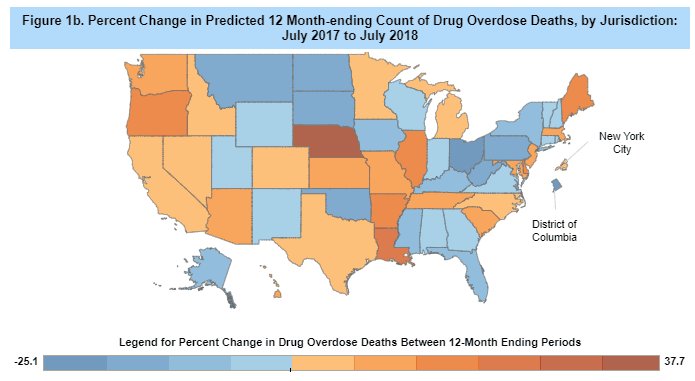At a time when most news about the opioid crisis seems to be bad, a recent study may be a cause for hope.
The January 2019 study by the Center for Disease Control (CDC) indicates that opioid overdose deaths in the U.S. have entered a plateau—and even a slight decrease.
Looking at the Study
The CDC’s study compared opioid overdose deaths in the period of June 2016 to June 2017 to opioid overdose deaths in the same period from 2017 to 2018. The data indicates a slight decrease in deaths from the all-time peak in 2017.
Noting the contrast between reported overdose deaths and predicted overdose deaths, “predicted” meaning adjusted in an attempt to compensate for under-reported deaths, the CDC noted a 2.5% decrease in reported overdose deaths compared to the previous year, and a 0.9% decrease in predicted overdose deaths.
The June-to-June comparison is the seventh consecutive such data analysis from the CDC to see an overall decrease in overdose deaths from the previous, after an all-time high in the CDC study measuring opioid deaths from November 2016 to November 2017.

To recap…
The numbers:
- 2.5% fewer reported overdose deaths June 2017-June 2018 compared to June 2016-June 2017
- 0.9% fewer predicted overdose deaths in the same period
- 67,446 total reported deaths June-to-June
- 70,652 total predicted deaths June-to-June
Important Qualifications to This Data
The CDC study is very heartening to us in the behavioral health industry, but we are responsible to note a couple things.
-
- “Less high” is still too high – Any decrease in overdose deaths is a step in the right direction, and we are encouraged to see the number falling in recent months. However, 67,446 overdose deaths are still 67,446 overdose deaths too many. If the turning point has been reached and the number of overdose deaths is in a lasting decline, as the CDC data suggests, there is still a long way to go and a lot of work to be done in addressing this crisis.
- Uneven results – While the CDC study shows a decrease on the nationwide level, the results when looking state-by-state show a different story. In fact, roughly half of U.S. states had a decrease in overdose deaths; the other half had an increase in this period. Washington, D.C., and Ohio saw the greatest improvement, at 26.2% fewer predicted overdose deaths and 21.4% fewer predicted overdose deaths, respectively. Meanwhile, Nebraska saw the greatest proportional increase in overdose deaths compared to any other state by far: 38% more predicted overdose deaths than the previous year.

See the CDC’s data for yourself here. AZZLY will be here to report on new developments in the industry. Follow us to stay informed.
AZZLY Rize is our all-in-one solution designed for facilities that specialize in mental health, addiction treatment, and eating disorders. Find out more about it. Contact us and we’ll send some free demos your way. Or you can schedule an appointment at your convenience and one of our EMR & RCM experts will give you a live, guided demonstration.




